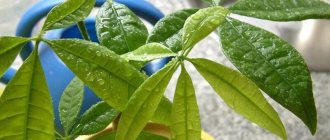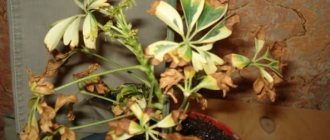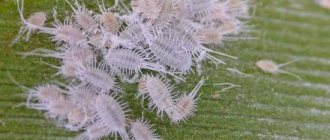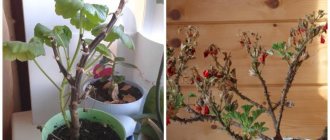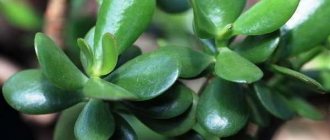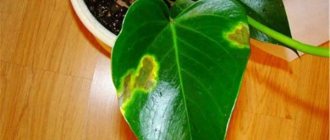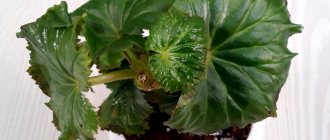Croton or codiaum is a magnificent indoor plant, of the Euphorbiaceae family, with very beautiful, bright leaves. In nature, it is found only in Southeast Asia, where it can reach about 4 meters in height. At home, croton grows no higher than 60-70 cm. Its characteristic feature is thick, fleshy leaves of different shapes and colors. The color can vary from greenish-yellow to orange-red, and even black, and the shape can be straight, lanceolate, with wavy or smooth edges, spade-shaped, twisted, etc.
Croton - a house flower with unusual foliage
Reasons why croton leaves dry and fall off
Croton is considered one of the most capricious and demanding plant conditions. The juice released when the stems of the plant are damaged is extremely poisonous, so when caring for croton you must be extremely careful and wear rubber gloves. Not recommended for families with small children and pets .
Growing it at home is not at all easy, but it is possible. The main thing is to monitor the appearance of the leaves. If they begin to turn yellow and fall off, there may be many reasons for this.
The main ones are:
- violation of temperature and light conditions;
- improper watering;
- damage by diseases and pests;
- insufficient humidity in the room;
- adaptation after transplantation.
Such symptoms often appear immediately when purchasing a plant. It is very difficult for Croton to get used to new conditions, but if all the necessary criteria are met, then after a couple of weeks the leaves will stop turning yellow and falling off. What to do when a plant starts to hurt, and how to properly care for it?
Watering
The cause of foliage loss may be a violation of the watering regime.
The cause of yellowing and loss of foliage in croton can be insufficient or excessive watering. It is important to ensure that the soil in the pot is always moderately moist.
Water the plant with warm (settled), soft water. Once every 2 weeks, the croton is given a generous shower, and the leaves are regularly sprayed. To prevent the soil from being washed away during this procedure, it is recommended to cover the pot with film. In summer, you will have to water the flower every 2-3 days, and in winter – once every 5 days.
Temperature
An equally important parameter for the normal growth and development of croton is the correct air temperature. It should not fall below +16, although such a temperature is already dangerous. Rooting of the root system and death of the plant may begin.
The ideal temperature in summer is between +23+25, no lower or higher, and in winter – up to +20. Croton does not tolerate sudden changes and temperature fluctuations. Any drafts are very dangerous for him.
Air humidity
Insufficient humidity causes yellowing and falling leaves
Croton grows well only in a room with high humidity, so it is recommended to place it on a special tray with moistened moss or expanded clay. A small amount of water is regularly added to the container, which, evaporating, creates the necessary conditions for plant growth.
Some experts advise not only spraying, but also gently wiping the croton leaves with a damp sponge or napkin. This will clear them of dust and dirt and humidify the air around them. Throughout the heating season, you can use electronic humidifiers. A dry indoor climate contributes to the development of many diseases and the appearance of spider mites.
Lack of microelements
Croton leaves often dry out and fall off due to a lack of nutrients in the soil. Timely fertilizing or transplanting into fresh soil can help.
To prevent yellowing of the leaves, it is necessary to regularly apply complex mineral fertilizers. In the period from April to November, the plant is fertilized twice a month, and in winter - once a month. Before applying fertilizers, the soil is well moistened, and minerals must be dissolved in water, according to the instructions.
Incorrect placement location
Croton should not be placed in close proximity to heating appliances
Croton does not grow well near window glass or next to heating appliances. Temperature changes are detrimental to the plant. The optimal place for it is wide window sills on the western or eastern side of the apartment.
It is important to ensure that there are no even short-term drafts, and to protect your exotic pet from direct sunlight . If there are no other reasons for the disease and loss of leaves, then you will have to change the location of the plant.
Failure to comply with lighting conditions
Croton feels best in diffused light. Direct sunlight is harmful to it. If the plant has not been under the scorching sun for long and has received a burn, then it is still possible to help it. It is enough just to move it to partial shade.
Withering
Why did the croton leaves drop?
What to do? In most cases, the reason for the wilting of croton leaves lies in the lack of lighting.
Leaves also droop when the soil gets too dry.
To cure a plant, start watering it, but gradually.
Under no circumstances
should you immediately flood the soil with water
, as this will cause the root system to rot.
.
To begin with, it would be a good idea to water the plant with warm water, to which you need to add Elina fertilizer.
After the soil dries, little by little
increase the volume of watering. You can also sprinkle a little water on the croton leaves.
Caring for croton at home is a painstaking and time-consuming process, and if all requirements are not met, the plant’s leaves begin to fall off. A beautiful plant with large leaves of interesting colors will give any room a completely different look.
If you find an error, please select a piece of text and press Ctrl+Enter
plant (lat. Croton)
, also known as codiaeum (lat. Codiaeum)
or
"Joseph's cloak"
, belongs to the genus of the Euphorbiaceae family. Nobody knows for sure what the name “croton” means, which gardeners liked more than the scientific “codiaum”, translated from Greek meaning “head”. Maybe this name comes from the name of a city in southern Italy, where Pythagoras once founded his school, or maybe in some dialect this word means “shrub”... The homeland of wild crotons are the islands of the Pacific Ocean and Northern Australia, India, as well as Southeast Asia.
The number of species in the genus varies from 17 to 1200, but in indoor culture croton flowers are represented only by variegated croton and its hybrids. The croton flower is one of the most beautiful decorative foliage indoor plants, which serves as an excellent interior decoration and, as a rule, does not take up too much space. In some countries, the croton houseplant is considered the guardian of the hearth, protecting the house from bad energy.
Diseases and pests
The cause of falling and yellowing of leaves is fungal diseases (anthracnose, root rot) or pest attack (scale insects, spider mites). How to save an affected plant without causing harm to it?
The first sign that a mite has settled on the leaves is the presence of a white coating on them. The reason for this is insufficient watering. With normal moisture, the poisonous sap secreted by the plant serves as excellent protection against pests. Dry, diseased leaves cannot repel ticks.
To get rid of it, it is enough to treat croton three times with any insecticide for indoor plants (Aktellik, Fitoverm, Akarin), with an interval of a week. Some gardeners recommend wiping the leaves and stems of the plant with a soap solution or tobacco infusion, preventing it from getting on the soil. After 50-60 minutes, the plant is carefully rinsed in the shower.
Croton can be attacked by scale insects
The scale insect rarely affects croton, and it appears in the form of small brown spots. They can be carefully removed using a cotton swab dipped in a soap-vodka solution (2 tablespoons of vodka/liter of water and a little soap). After 2-3 hours, the solution must be washed off. As a rule, one treatment is enough to completely get rid of pests.
Excessive watering and high humidity lead to the appearance of anthracnose on the leaves. The plant can only be cured by treating it with fungicides. The procedure is carried out at least 3-4 times every 10 days.
Excessive humidity is also dangerous due to rotting of the root system, which also manifests itself in the form of yellowing and falling leaves. This condition most often occurs in recently purchased young plants. Replanting in nutritious soil from leaf and turf soil with the addition of peat, humus, sand and charcoal, taken in equal parts, can help. A layer of drainage must be placed at the bottom of the pot.
Newly acquired plants are replanted only after acclimatization.
Replanting is carried out by transshipment (every spring), and damaged roots are carefully removed (without destroying the earthen ball). Old plants cannot be replanted often. One transplant every three years is enough.
Withering
Why did the croton leaves drop?
What to do? In most cases, the reason for the wilting of croton leaves lies in the lack of lighting.
Leaves also droop when the soil gets too dry.
To cure a plant, start
watering it, but gradually.
Under no circumstances should you immediately flood the soil with water.
, since after this
the root system will begin to rot
.
To begin with, it would be a good idea to water the plant with warm water, to which you need to add Elina fertilizer.
After the soil dries, little by little
increase the volume of watering. You can also sprinkle a little water on the croton leaves.
Caring for croton at home is a painstaking and time-consuming process, and if all requirements are not met, the plant’s leaves begin to fall off. A beautiful plant with large leaves of interesting colors will give any room a completely different look.
Maybe it's because of the temperature difference? At first it was cold, then the heating was turned on, it became hot... or what? What to do?
Your assumption is correct. When watering croton, you need to pour water until excess appears in the pan. After 2 hours, the water must be drained from the pan so as not to harm the roots (by the way, check their condition by pulling the plant out of the ground; if there are rotten roots, then they must be removed by treating the cut area with crushed activated carbon to prevent disease). Before the next watering, the TOP layer of soil should dry out slightly. In winter, watering is more moderate (i.e. water when the soil dries 2-3 cm deep). At the bottom of the pot, provide good drainage to prevent stagnation of water. Good luck!
How about watering? Maybe it hasn't been watered for a long time? Croton loves moisture and drops its leaves if not watered enough.
First, take out the plant in their pot and inspect the roots - maybe there is nothing left to save. Based on the condition of the roots, you will see whether it is underwatered or overwatered, and you will take appropriate measures. In general, crotons do not like temperature changes and temperatures below 18 degrees. over a long period of time (5-6 hours is enough) is already critical for the plant, especially if the flower has recently been watered - wet roots cool faster. temperature above 26 degrees. - also poorly tolerated, especially if the humidity is low - when the batteries are turned on, the air humidity drops significantly. - increase humidity in ways available to you.
There can be many reasons: overflowing or drying out of the earthen clod, draft. temperature changes, presence of pests, replanting, moving from place to place. It is necessary to adjust the watering - water after the earthen clod dries halfway. Be sure to maintain high air humidity. Spray the plant with epin once a week - it will help it recover. If the ground is too wet right now. then you need to wrap the earthen ball in newspaper or toilet paper and change it when it gets wet.
Pests and diseases: Affected by red spider mites and scale insects.
Special difficulties:
Dropping of lower leaves - brown leaf tips - air or soil too dry.
Brown leaf edges indicate too low a temperature.
Leaves lose color - there is not enough light.
Care features: The plant is poisonous!
If the leaves begin to lose their color, it is necessary to increase the lighting.
In horticulture, codiaums are sold after hardening - for this, the temperature is reduced to 20°C, and then to 18°C. Plants prefer moderate heat throughout the year. The optimal temperature for codiaums is at least 20 - 22 °C, but they can tolerate lower winter temperatures (but not lower than 16 °C) if the soil is almost dry. They bloom annually and profusely. With a long stay at a temperature of 10-12 ° C, the leaves fall off. You can place plants near radiators, wrapping the pots with damp moss to evaporate the water.
Codiaum really does not like temperature changes and drafts.
Croton or codiaum is a magnificent indoor plant, of the Euphorbiaceae family, with very beautiful, bright leaves. In nature, it is found only in Southeast Asia, where it can reach about 4 meters in height. At home, croton grows no higher than 60-70 cm. Its characteristic feature is thick, fleshy leaves of different shapes and colors. The color can vary from greenish-yellow to orange-red, and even black, and the shape can be straight, lanceolate, with wavy or smooth edges, spade-shaped, twisted, etc.
Croton - a house flower with unusual foliage
Tips and tricks for caring for croton
Croton is a very capricious plant to care for.
Caring for croton is not an easy task. It is necessary to strictly observe the temperature regime, monitor watering and humidity, and provide good, moderate lighting. In the summer-spring period, much attention is paid to fertilizing, spraying and watering. In winter, you will need additional lighting, reduced watering and a lower temperature in the room. If you follow these rules, growing croton will not cause much trouble.
Temperature
The flower is very picky about temperature conditions. When the temperature is too low, almost all life processes stop and it stops growing. Codium practically goes into suspended animation. As a result, the leaves dry out at the tips and then fall off. The process starts at +14 °C. If the croton has shed all its “plumage”, it is likely that it is already on the verge of death.
The reason why the croton dropped its leaves may be too high a temperature. If the thermometer is above +24 °C and the air is dry, then it is likely that the flower feels uncomfortable precisely because of the heat.
Croton is losing its leaves
look also here. or -
Codiaeum variegata, or also called croton, has always been a very rare, prestigious and very expensive houseplant. You understand this when you see a beautiful tree-like bush, dressed in a luxurious outfit of fancy leaves. The crown of upper veins, light in tone and filled with bright gold, seems to glow from within. The lower and more mature the croton leaves are, the darker they are, up to a noble burgundy, and also seem to be painted with gold.
Among the varieties of croton (variegated codiaum), there are forms with broad-lobed leaves, others with forked and ribbon-shaped leaves, and some have leaves dissected with brightly colored veins.
Croton has its own peculiarity - at a young age, yellow and various shades of green tones predominate on its leaves; with age, pink and red spots and stripes appear.
Croton propagates by stem cuttings, which are rooted in water. Rooting takes a very long time - 1.5-2 months. Cuttings should be kept at a temperature not lower than +23-25°C. The rooting container should be opaque. It is advisable to cover the cuttings with a bag to increase air humidity.
It is often said that caring for croton is difficult, and the plant itself is extremely capricious, but this can be said about other house flowers too, because every flower needs careful care and attention. What does Croton need to please us with its splendor? To ensure croton growth, it must be replanted annually in new fertile soil and systematically fed during the period of active growth.
Croton achieves its greatest beauty only in good light - but with a lack of light, the leaves lose their color intensity. In summer, it is better to shade the croton from the sun during the hottest hours, and the most ideal place for this house plant is an eastern or western window.
The substrate should neither dry out nor become waterlogged. In summer, croton requires a lot of water; in winter, watering should be reduced: the soil should dry out between waterings. Excess water, at any time of the year, leads to various diseases.
Croton does not tolerate the dryness of the earthen clod well, and the plant can shed almost all its leaves. Does not tolerate watering with cold water and drafts. Croton should be watered with warm, settled water. The temperature should be constant throughout the year, but not lower than 16°C. With sharp temperature fluctuations and drafts, croton sheds its leaves.
If the lower leaves of the croton fall off, to slow down this process, start spraying the plant - croton loves moist air. So croton needs to be regularly sprayed and wiped with leaves.
Young plants are replanted annually in March-April, old plants - after 1-2 years. For replanting, take an earthen mixture of 2 parts leaf soil, 1 part turf soil, 1 part river sand and pieces of charcoal.
Most often, croton is affected by scale insects (the leaves lose color, dry out and fall off). Dry indoor air promotes red spider mite infestation (solid whitish spots form on the surface of damaged leaves, leaves fall off prematurely).
For good growth, croton needs a light place (so that the leaves do not turn pale), but without direct sunlight, warmth, sufficient watering, spraying and maintaining high air humidity. Young leaves may fall off from:
— drying out of the soil (there should be abundant watering in summer and moderate watering in winter; after watering, excess water must be removed from the pan);
- lack of nutrition in the soil (2 weeks after purchasing an imported croton with poor peat soil in a pot, it must be transplanted into nutritious soil consisting of turf, leaf, humus soil, peat and sand in equal parts with the addition of pieces of charcoal in a slightly larger a pot with good drainage; then replant young actively growing crotons every 2 years, and old ones only when necessary);
- lack of fertilizer (from March to August, apply a little fertilizer every week).
Perhaps moved to a darker place? Or is it too dry? Overflow is less likely; the flower loves water, but this cannot be ruled out. Loosen the soil deeper and carefully. Air access to roots. If only 1-2 leaves fall off, this is normal. If there is leaf fall, there is something wrong with the roots. They dried up, suffocated, froze.
By dropping leaves, croton, or codiaum, reacts primarily to cold and drafts. Check if your plant is in a draft. High air humidity on a rainy day, on the contrary, is very favorable, however, due to lack of lighting, the bright color of the leaves fades, and sometimes they even lose color and turn green. When caring for croton, it is very important to prevent the roots from overcooling. Therefore, if the windowsill is cold, it is better to place the pot on a wooden stand.
Change of plant color
Why do croton leaves turn yellow? If the flower has changed color, this may indicate insufficient lighting.
Croton requires quite a lot of light, but it is still better not to place it in direct sunlight, since due to burning of the leaves, the plant also loses its former color and begins to turn unnaturally yellow.
How can you tell if codiaum has too much light? Brown spots will begin to appear on the leaves of the flowerpot.
If the plant does not turn yellow, but simply fades, it means that it most likely lacks microelements in the soil, especially nitrogen.
Why does croton have green leaves? This may be due to the fact that the plant is young.
In this case, you should provide the croton with good feeding.
Why do croton leaves dry and fall off and what to do about it?
Croton (Codium) grows in tropical forests. At home, it is demanding of care, since it requires an appropriate microclimate. Below we will consider the main reasons that lead to a plant shedding its leaves.
Improper watering
One of the reasons that causes the leaf blades of codiaum to turn yellow and fall off may be excessive or insufficient amount of water for irrigation. In these circumstances, to save the plant, it is necessary to ensure that the soil in the flower pot is moderately moist.
Violation of containment conditions
The problem may lie in non-compliance with the necessary maintenance conditions for codiaum, such as incorrect temperature conditions and dry air in the house.
Watering
Fleshy and glossy leaves are most often moisture-loving, so these flowers must be watered regularly. But overwatering is also fraught with consequences in the form of black rot of the roots.
Before watering again, you need to poke your finger into the soil; if it is wet at a depth of 1 centimeter, then you do not need to water it yet; if it is already dry, then you should not delay this procedure. Always water with settled water at room temperature.
If in summer it is watered every three days, then in the autumn-winter period watering is usually reduced to once every five days. But spraying the leaves is done more often than in summer, since the air in the room becomes very dry due to heating.
If you water it as often in winter as in summer, then excess moisture will accumulate in the lower part of the pot, which will lead to root disease, which can cause the leaves to dry out. Therefore, during replanting, you must take care of a thick layer of drainage at the bottom of the pot.
Useful tips for growing croton
In order for the codiaum to grow healthy, certain conditions must be met:
- the right pot. The growth of a flower is directly related to the state of its root system, so the pot must be chosen with special attention. It should be wide and not very deep. If you take a pot that is too wide, water for irrigation will accumulate at the roots, which will cause rotting of the root system. You need to take a stable and practical pot. It is better not to use a clay pot - it is heavy and can create some inconvenience for the codiaum. The best option for codiaum is a plastic pot;
- transfer. For young plants, this procedure should be carried out annually; for older plants, it is permissible to do this every other year. The optimal time of year for transplantation is early spring. Croton needs to be replanted in fertile soil, which includes charcoal, river sand, leaf and turf soil. When replanting, the size of the pot should be several centimeters larger than the previous one;
- pinching and trimming. To make croton look neat, young plants are pinched, and adults are pruned. The first pinching is done after the codiaum reaches a height of 15 cm, subsequent pinchings are done every time the stems grow 20 cm. When pruning an adult codiaum, the cut sites are treated with charcoal;
- bloom. Croton flowers do not have decorative value, but flowering takes a lot of energy from the bush. If there is no need to collect seeds, flower buds or peduncles should be removed immediately after they form.
Mistake #5. Refusal to trim
Many amateur gardeners do not form croton because of its poisonous milky sap. Refusal to trim leads to loss of the tree's shape and often becomes an indirect cause of depletion of the grown plant from lack of nutrition and crowded conditions on the windowsill. The compact crown of this capricious plant is easier to care for.
Stem cuttings can be safely used to propagate the plant. First, the milky juice is washed off from them. Rooting (in a mixture of sand and peat) occurs faster with lower heating (for example, on a windowsill above a hot radiator), warmth (plus 23 - 25°C) and the use of phytohormones (you can soak the cuttings in aloe juice). This takes 1 - 1.5 months. Spring (March - April) is the best time to root cuttings, although propagation is possible throughout the year.
Croton bush becomes more luxuriant from pruning
In good conditions, croton blooms annually. Yellowish-white small flowers are collected in racemes that appear in the axils of the upper leaves. If you do not want to grow a new tree from seeds, then you should not allow it to bloom so as not to deplete the plant.
Prevention measures
The main preventive measure to avoid the problem of fallen leaves in croton is to follow the rules of caring for it, the main points of which are:
- suitable indoor air humidity;
- a warm place with good lighting;
- insulation from direct sunlight;
- proper watering, in which the soil is always moist;
- insulation from drafts;
- timely feeding;
- avoiding sudden temperature changes;
- Regular inspection for diseases and pests.
When croton leaves fall, the first step is to identify the exact cause of this problem in order to take the right steps to eliminate it. Knowing how to properly care for this plant and following preventive measures, you can grow a healthy flower that will delight you with its beauty.
Temperature
Since codiaum is a tropical plant, the best air temperature for it is:
- In summer +24°C.
- In winter +20°C.
If the air temperature in the room drops slightly below +15°C, then the codiaum almost stops growing, its leaves dry out, starting from the tips, until they completely fall off, and the roots begin to rot. In very hot weather with dry air, when the temperature exceeds +25°C, the leaves become lethargic.
For the same reason, it is not advisable to expose croton to direct sunlight. Partial shade suits him best. And it must be protected from drafts.
What to do if croton leaves fall off?
Croton has long and rightfully won the hearts of flower growers. This is an amazingly beautiful plant with a bright, unusual color of leaves, which reaches a meter in height in a few years. In addition, this flower is very unpretentious. Probably the only problem that its owners face is yellowing and dropping of leaves.
Causes of yellowing leaves
The croton's homeland is considered to be Oceania and the countries of Southeast Asia, where it grows in tropical forests, which is why maintaining comfortable living conditions with warm air and high humidity is very important for domestic crotons. This plant requires moderate watering, regular replanting and fertilized substrate. The flower is demanding on lighting; it does not tolerate any drafts.
Any unfavorable change in the habitat immediately causes a negative reaction in croton - it begins to turn yellow and shed its leaves. However, in the vast majority of cases, a green pet can be saved if timely measures are taken to resuscitate and restore it.
Watering
Most often, croton sheds its leaves due to a violation of the irrigation regime. Like most tropical exotics, it prefers moist air and good irrigation, which is why it is important to carefully monitor the condition of the soil - it must be constantly moist. This is true both in summer, when the weather is hot outside, and in winter, when heating is on in residential areas.
Lighting requirements
Light is the second factor that can ruin your growing. Croton (photo) requires a lot of sunlight, but not direct sunlight - it burns the leaves, which are unable to recover. In winter, it is better to keep the flower on a south or east window - the rays are cold, and it receives only what it needs. As summer approaches, the pot needs to be moved to a quieter place, to the north or west. Moreover, you need to gradually accustom the plant to more intense sun. If you do not guess with the degree of illumination, the leaves will become primitive green, and the croton will lose 90% of its attractiveness.
Diseases and pests
The reason crotons turn yellow and drop their leaves is often a plant disease or an attack by insect pests.
Of the diseases, culture most often faces the following problems.
- Anthracnose - in this case, reddish and ash-gray spots of arbitrary shape form on the leaves, and soon after their appearance the leaves begin to fall off.
The diseased plant must be isolated, then transplanted into a new substrate and a new pot, and then sprayed with special preparations. “Cumulus”, “Fundazol” and “Euparen” are characterized by maximum efficiency.
- Root rot - yellowing and pallor of leaves is considered the very first sign indicating such a disease. If you dig up a plant, you will notice that the roots have begun to rot - this happens due to low acidity of the soil.
To revive your green pet, you should cut off all the affected areas, replant the plant in nutrient soil and water the fungicides “Fitosporin” or “Alirin-B” at the root.
Of the pests, the following parasites cause the greatest harm to croton.
- The spider mite is a very small spider, which is quite difficult to detect with the naked eye, but its appearance can be judged by the thin gray-silver webs on the back of the leaf. The parasite sucks out the vital juices of the plant, which leads to its withering. To get rid of the mite, you need to wash the leaf blades and young green stems with shag infusion with the addition of laundry soap or treat them with special insecticides.
- Scale insect - this insect can be identified by characteristic plaques on the inside of leaves and stems. The danger of scale insects is that they multiply very quickly and can destroy even a large plant in the shortest possible time. You can save the flower by washing it with tobacco infusion or soap solution.
Dry air
Dry air in an apartment is a common problem during the heating season. Croton does not like dryness. Because of this, the edges of its leaves dry out. You can save a flower with a few simple measures.
- Place the pot with codiaum on a tray with damp peat, moss or expanded clay. Add water regularly. Then it will constantly evaporate, creating a more favorable microclimate.
- Sprinkle regularly. For the procedure, it is advisable to use warm water that has stood for several days. It is advisable that it be at room temperature or 1-2 degrees warmer. Before sprinkling, it is advisable to wrap the pot with film to avoid washing out the soil.
- Wipe the leafy part with a damp cloth, napkin, or sponge. This will not only moisten the croton itself and the air next to it, but will be an excellent means of combating dust accumulating on the leaf plates.
- Use special devices - humidifiers, air purifier.
At a high level of humidity, the leaves of the crop do not wither for a long time, remain bright, and do not lose turgor.
Dry air and large amounts of dust provoke various diseases and cause attacks by pests - spider mites. Due to the unfavorable microclimate, the natural immunity of codiaum is greatly reduced.
